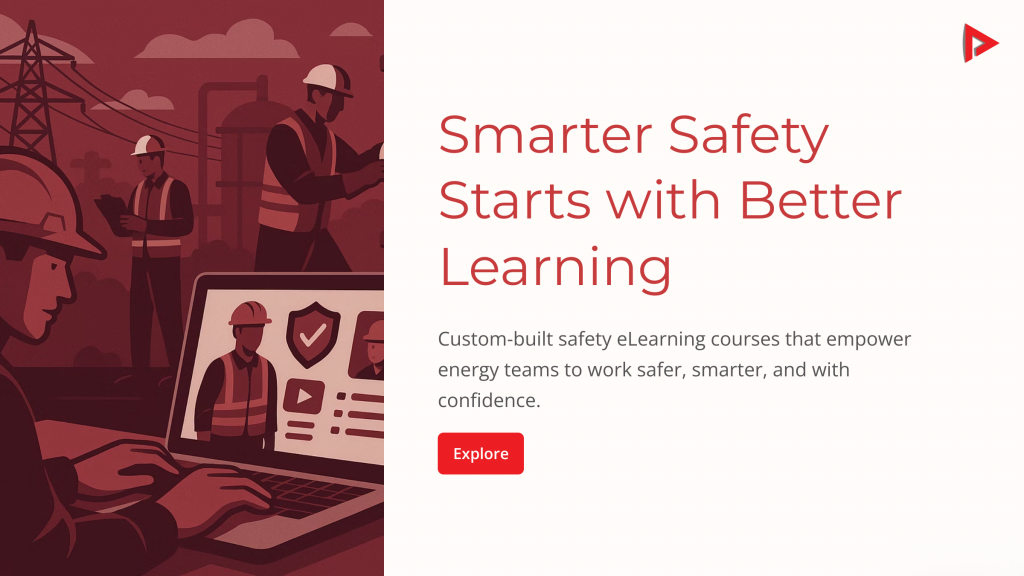
In the energy sector, safety is the foundation of operational integrity. But as technologies evolve and environments become more complex, traditional safety training often struggles to keep pace. Static slide decks and compliance checklists can’t equip workers to navigate dynamic, high-risk situations with confidence.
That’s where tailored safety eLearning courses step in.
Strategically designed safety courses engage learners through immersive experiences, real-world scenarios, and role-specific content that reflects the realities of the field.
Why Traditional Safety Training Methods Often Fall Short
In high-stakes industries like energy, outdated training methods can carry serious consequences. Yet many organisations still rely on static manuals, slide-based sessions, or generic eLearning modules that fail to address the real-world complexities of their operations. The result? Low engagement, limited retention, and training that doesn’t translate into safer behaviours on site.
Traditional safety training often overlooks three critical factors:
- Contextual relevance: Generic content doesn’t reflect site-specific hazards or procedures, making it harder for teams to apply what they’ve learned when it matters most.
- Learner engagement: Passive learning formats (like reading policies or watching non-interactive videos) don’t capture attention or encourage critical thinking in high-risk scenarios.
- Scalability and adaptability: As regulations shift and technologies advance, traditional training lacks the flexibility to evolve in real-time or meet the diverse needs of a distributed workforce.
For safety training to be truly effective, it must mirror the complexity of the environments it supports. That means adapting to roles, reinforcing behaviours, and providing experiences that stick both cognitively and operationally.
What Makes Safety eLearning Projects Work?
For energy sector teams working in unpredictable, high-risk environments, successful training must do more than inform. It must engage, adapt, and empower.
Interactivity and Immersive Design
When learners actively engage with content (rather than passively consuming it) they’re more likely to retain information and apply it in the field. High-impact safety eLearning uses:
- Simulated scenarios that mirror real-life risks and encourage critical decision-making.
- Branched storytelling to explore cause and effect, helping workers understand the consequences of unsafe actions.
- Gamified elements like quizzes, challenges, or role-play to sustain motivation and reinforce learning.
This kind of design turns safety from a theoretical concept into a lived experience, one that’s easier to remember and act on under pressure.
Microlearning for On-Site Accessibility
Energy operations are fast-paced and geographically dispersed. Learning solutions must meet teams where they are, often on-site, on-the-go, and pressed for time. Microlearning addresses this by:
- Breaking down complex safety protocols into short, digestible modules.
- Offering mobile-friendly access so learners can refresh knowledge as needed, right from the field.
- Supporting just-in-time learning to address emerging risks or procedural updates immediately.
This approach supports continuous learning and makes safety knowledge a regular part of day-to-day operations.
Inclusive, Role-Based Personalisation
A one-size-fits-all approach can alienate learners and dilute impact. Customisation ensures that content speaks directly to the specific risks, responsibilities, and environments each role encounters. Effective personalisation includes:
- Adapting content for frontline workers, engineers, supervisors, and new hires.
- Localisation for different languages, literacy levels, and cultural contexts.
- Accessibility features such as voiceover, captions, and screen-reader compatibility.
By designing for diversity, safety eLearning becomes more inclusive and more effective across the board.
Our Approach to Digital Safety Training in High-Risk Industries
Our approach brings together instructional designers, industry specialists, visual storytellers, and digital technologists to co-create learning that’s as strategic as it is engaging. Every solution is purpose-built to reflect the environments, challenges, and responsibilities of your teams.
Multidisciplinary by Design
Safety training isn’t siloed. It’s shaped by human behaviour, technology, regulation, and organisational culture. We draw from all these disciplines to ensure every learning experience is:
- Technically accurate through collaboration with HSE and engineering experts.
- Instructionally sound using proven adult learning principles and evidence-based design.
- Creatively inspired with motion graphics, animation, and narrative techniques that keep learners engaged.
Client Collaboration at Every Stage
From stakeholder interviews to field observations, our process is consultative and adaptive. We ensure the final product reflects your team’s voice, policies, and priorities, while elevating learning outcomes through thoughtful design.
Future-Focused, Ethically Driven
We integrate emerging technologies such as VR safety walk-throughs always through a human-centred lens. Innovation is only valuable if it empowers people and aligns with your goals.
Partnering for Sustainable Learning Outcomes
We work as strategic partners from the outset, embedding collaboration into every phase of development. Our co-design process ensures that each eLearning solution aligns with your operational objectives, regulatory requirements, and on-the-ground realities. But we don’t stop there.
Post-launch, we support your teams with ongoing updates, performance insights, and learner feedback loops, enabling your safety programmes to evolve alongside industry standards, technology, and team needs. This sustained engagement ensures that safety learning remains relevant, practical, and measurable.
Partner with Anderson Studios to co-create eLearning that empowers your teams and protects what matters most. Contact us today!

